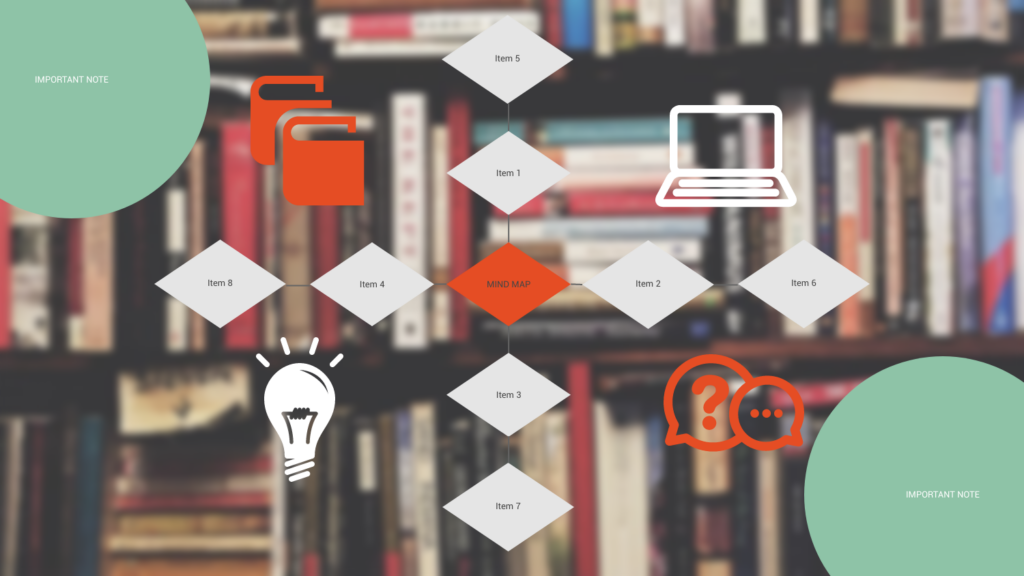Your heart beats faster, your hands get sweaty, your breathing gets shorter, and your face turns red. Do you ever get this reaction before giving a presentation? You aren’t the only one. In fact, 73% of the population is affected by public speaking anxiety or glossophobia. We all know this nerve-racking feeling, and a lot of people try to avoid it as much as possible. However, when it’s your job to present in front of an audience, you have to find ways to calm your nerves and give it your best shot. So, next time you’re wondering how to not be nervous for a presentation, try these 6 effective tips that will help you calm down.

#1 Get to the root of the problem
You may have already tried some easy techniques to calm your nerves, but are you still finding yourself dreading public speaking? The best and most effective thing to do is to get to the root of the problem. A lot of times our stresses and fears are masking a greater issue. You might feel stressed before a presentation but in actuality, this could be a fear of rejection because of a traumatizing experience. Ask yourself, what is this stress really about? What is the worst-case scenario for you, and why?
By getting to the root of the problem, you’ll be able to rationalize it. It’s far more effective to understand the problem first before you try to solve it. From thereon, you can try to work with the issue. Ask for help or guidance from others who have experienced the same issue and learn to deal with it on a more practical level.
#2 Be prepared
One of the most obvious reasons why you feel nervous about a presentation is that you aren’t prepared for it. As they say, practice makes perfect. And it couldn’t be more true in this case.

Every great presenter you’ve watched has probably rehearsed his speech a million times. Any great mastery comes from continuous practice, not talent. As a phenomenal example, Alex Honnold climbed a 3000-foot (900m) rock formation without any safety gear in July 2017. The free solo climber practiced climbing the El Captain rock roughly 50 times with safety gear before free soloing the rock formation. After reaching the top of the mountain, in an interview, he confidently stated that there was no uncertainty in this climb because he “knew exactly what to do the whole way.”
Presenting in front of an audience isn’t a life or death situation, but it does have some risks as many situations in life do. Making sure that you know your material so well that you could recite it in your sleep, will make you feel much more confident and comfortable when presenting.
Tip: Practice your presentation in front of your partner, family, or friends. This practice will help you memorize your material and mentally prepare you for speaking in front of an audience.
#3 Organize everything to a tee
Are you using videos, audio, visual aids, or props in your presentation? Make sure everything is organized to a tee. The last thing you want is to worry about a video that won’t play or poor-quality audio materials. Preparation ahead of time will ensure that you’re not surprised with sudden stresses right before or during the presentation.

Also, you’ll want to plan out your presentation. You can even create a mind map for yourself. It’ll help you organize your thoughts and key points, making sure that you remember all the main focus areas you want to touch on during your presentation. The best part is that you don’t even have to take out your pen and paper to create a mind map, you can simply choose one of the Prezi Present templates and create your mind map there.
If you want to discover other practical tips, check out our article on 4 easy ways to prepare for a presentation.
#4 Try breathing exercises
If you’re searching for how to calm down before a presentation, you may have stumbled upon a few breathing exercises. They’re one of the most simple yet highly effective ways to calm down, and only take a few minutes to do. This is something you can easily do right before your presentation to help you relax.

An easy breathing exercise that you can try right away is taking a big inhale while counting until four, then holding your breath for another four, and then exhaling for five. Close your eyes and remove all distractions to make this exercise even more effective. Repeat this cycle at least three times or until you feel calmer and notice that your heart rate has slowed down a bit. If you’re interested in other breathing practices, check out the Healthline article with 10 breathing exercise examples.
#5 Focus on your material, not the audience
Stress usually comes from overthinking, and overthinking is an unnecessary process that happens when we focus on the wrong things. Instead of focusing on what your audience will think about your presentation, focus on the presentation itself. Get excited about the topic. Don’t linger on what you think your audience will think. Overthinking your assumptions and worries will only drain your energy and make you feel powerless in a situation like this. Focusing on things that you can control, like your performance, will help you feel more confident and collected when presenting. So, next time when you are starting to overthink, recognize these thoughts as unnecessary distractions and shift your focus back on your presentation.
#6 Adopt the power of pacing
It’s not just what you say; it’s how you say it. Pacing can really help you with nerves. Try rehearsing your presentation with varying speeds and notice how it affects your delivery. A measured pace can make you feel more in control, which in turn, can ease those presentation jitters.
#7 Channel your nerves into excitement
Here’s a fun fact: the physiological response to nervousness is similar to that of excitement. Use this to your advantage. When you feel those familiar symptoms of anxiety, tell yourself, “I’m not nervous, I’m excited!” This simple mental switch can change your mindset and reduce presentation stress.
#8 Establish a connection with your venue
Familiarity breeds comfort. Arrive early and get to know the space where you’ll present. Walk around, stand on the stage, and practice speaking with the microphone. The more comfortable you are with your surroundings, the less you’ll feel nervous about the presentation.
#9 Dress for success
Never underestimate the power of a good outfit. Wearing something that makes you feel confident can give you an extra boost of positivity. When you know you look good, you’ll likely feel good, and that can be a game-changer when it comes to presentation stress.
#10 Don’t be afraid to mess up
You can’t control everything. Sometimes accidents happen and things fall apart. You have to keep an open mind and trust the process. Most importantly, you have to trust yourself and build your confidence, so that whatever situation is thrown at you, you’ll feel calmer and collected to deal with it.

Also, remember to take any failure as an opportunity to learn. When looking back at your previous presentations, recognize what you succeeded in and what you could have done better. Whenever you receive criticism, don’t dwell on it but take it as an opportunity to grow and improve. At the end of the day, it’s up to you to become a better presenter, and the best way to do it is by trial and error.
We all have been there. Either underprepared or overstressed. If presenting in front of an audience is something new to you, the first few times will inevitably feel more nerve-racking. However, the more you do it, the less stressful it will become. If you’re asking yourself how to not be nervous for a presentation, remember that there are millions of people who are asking the same question. You’re definitely not alone in this. If you want to learn not only how to calm down before a presentation but also how to overcome the fear of public speaking, discover useful tips by a long-time television professional Jessica Marble in this video:
Understanding your stress signals
When you’re wondering how to not be nervous for a presentation, one effective strategy is to become adept at interpreting your body’s stress signals. Our bodies often communicate through symptoms like rapid heartbeat, sweating, or trembling before we consciously recognize our nervousness about a presentation. These stress signals are natural and everyone experiences them to some degree; they’re part of our built-in alarm system.
Instead of trying to suppress these feelings, acknowledge them. See them as indicators that your body is gearing up for something important. By doing this, you can begin to associate these signals with preparation rather than imminent danger. This is a form of cognitive reframing that can significantly reduce presentation stress.
Taking deep breaths can help to regulate your heart rate and calm your nerves. Visualizing a successful outcome can also shift your focus away from the physical sensations of stress. Remember, these signs are not your foes; they are simply your body’s way of preparing you to rise to the challenge. It’s a matter of harnessing them to your advantage.
By understanding and working with your stress signals, rather than against them, you can approach your presentation with a sense of readiness and control.
Reflect, refine, and reaffirm
Embrace the power of reflection
As the final slide fades and the audience applauds, take a moment to bask in your accomplishment. You’ve just delivered a presentation, and regardless of the butterflies, you made it through. Now’s the time to harness the experience to bolster your future endeavors in public speaking. Ask for feedback from your peers, mentors, or audience members—anyone who can provide constructive insights. This feedback is golden, as it helps you gauge the impact of your presentation and highlights areas for improvement.
The art of fine-tuning
With feedback in hand, reflect on your delivery. What aspects resonated well? Which parts could have flowed better? Perhaps you’ll find that preparation can indeed stave off those nerves, reinforcing the importance of how to not be nervous for a presentation. Identify one or two key areas to focus on next time—maybe it’s your pacing, your visuals, or the way you engage with the audience. Small, targeted changes can have a big impact, boosting your confidence and competence.
Looking forward with confidence
Wrapping up, it’s clear that public speaking is a journey, not a one-off event. Each presentation is a stepping stone to becoming a more skilled and self-assured communicator. You’ve learned to get to the root of your fear, prepare meticulously, organize your content, practice deep breathing, focus on your material, and accept imperfection. Now, you can add to that the importance of tuning into your stress signals and using each experience as a learning opportunity.
As you reflect on today’s presentation and plan for the next, remember that the feelings of being nervous about a presentation are a natural part of growth. The key is to use them, not fear them. With each step, you’re not only learning how to not be nervous for a presentation but also discovering your unique voice and style. With this knowledge, you step into your next presentation ready to excel.
